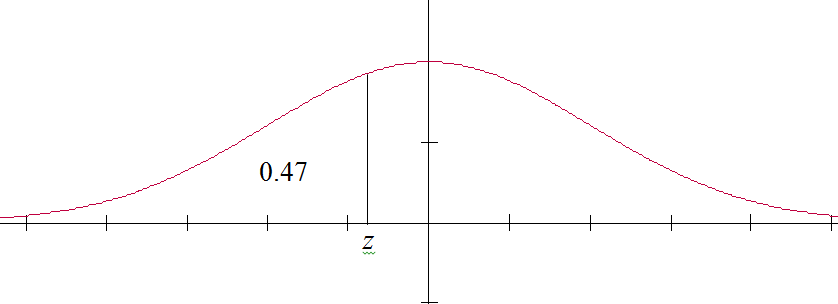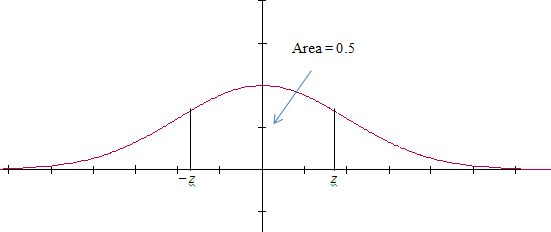
Finding Values in Normal Distributions
Example 1: Find X such that 47% of values in a normal distribution with mean 23.2 and standard deviation 5.8 are less than X.
In this type of problem you fist find the z-score for X and then convert to X using X = m + sz.
The picture for z in the standard normal distribution is

Note that the area to the left of z is 0.47. Note that the total area under the curve is 1, so the area left of center is 0.5, making z somewhat to the left of center. On the TI83+ to find z use invNorm(area left of z). In this case z = invNorm(0.47) = ̶ 0.0753
Then X = m + sz = 23.2 + ( ̶ 0.0753)5.8 = 22.7 (The answer is rounded to one decimal place because the given values have one decimal place.)
Example 2: A admissions test has a mean of 237 and a standard deviation of 36. Only the top 10% will be selected for admission. Find the cut-off admission score. Round to the nearest whole number.
The z-score for the cut-off is found using the following picture:

To find z on a TI83+ you need the area to the left of z. Since the total area is 1 the area left of z is 1 ̶ 0.1 = 0.9. Then z = invNorm(0.9) = 1.282.
Then X = m + sz = 237 + 36(ans) = 283.14. The cut-off score is 283
Example 3: A admissions test has a mean of 237 and a standard deviation of 36. Find the range for the middle 50% of scores. Round answers to the nearest whole number.
You need to find z-scores that cover the middle 50% of values. Since the picture is symmetric you get values z and ̶ z as in the following picture:

To find z on a TI83+ you need the area to the left of z. Since the total area is 1 the area in the tails is 1 ̶ 0.5 = 0.5 . The picture is symmetice so half of 0.5, or 2.5 must be in each tail making the total area left of z = 0.75. Then z = invNorm(0.75) = 0.6745.
The scores that cover the middle 50 of values are X = m + sz = 237 + 36(0.6745) = 261.282 and X = m ̶ sz = 237 ̶ 36(0.6745) =212.78 The range for the middle 50% of scores is 213 to 261.